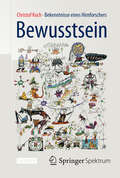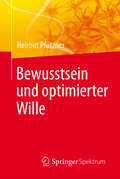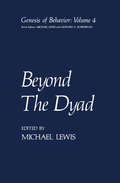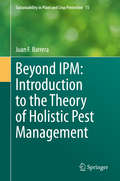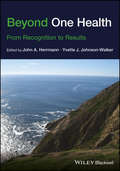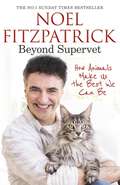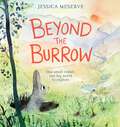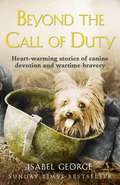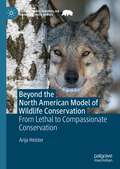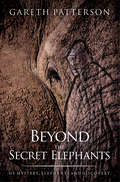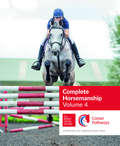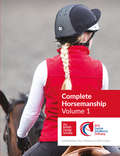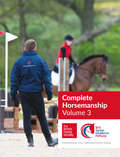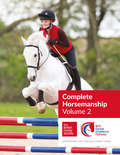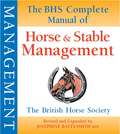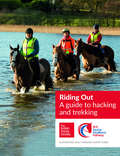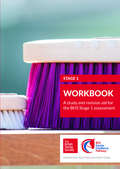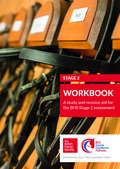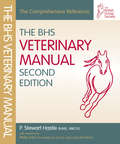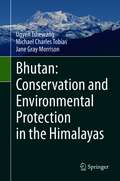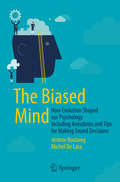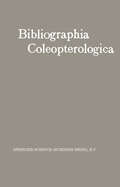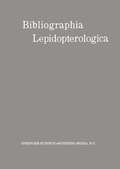- Table View
- List View
Bewusstsein: Warum es weit verbreitet ist, aber nicht digitalisiert werden kann
by Christof KochBewusstsein – das weiter verbreitet ist als bisher angenommen – ist das Gefühl, lebendig zu sein, es ist kein Rechenvorgang und auch kein cleverer Trick. In diesem Buch liefert Christof Koch eine schnörkellose Definition des Bewusstseins als bewusstes Erleben, vom alltäglichsten bis zum außergewöhnlichsten – eben das Gefühl zu leben.Die Psychologie erforscht, welche kognitiven Vorgänge einer bewussten Wahrnehmung jeweils zugrunde liegen. Die Neurowissenschaft spürt den neuronalen Korrelaten des Bewusstseins im Gehirn nach, dem Organ des Geistes. Aber warum das Gehirn und nicht etwa die Leber oder ein anderes Organ? Wie kann das Gehirn, drei Pfund höchst erregbares Gewebe, ein Gegenstand im Universum, der denselben physikalischen Gesetzen gehorcht wie jeder andere Gegenstand, subjektives Erleben hervorbringen? Will man eine Antwort auf diese Frage finden, braucht man, so Koch, eine quantitative Theorie, die beim Erleben ansetzt und zum Gehirn fortschreitet. Im vorliegenden Buch umreißt der Autor eine solche Theorie, basierend auf der integrierten Informationstheorie. Koch beschreibt, wie die Theorie viele Fakten zur Neurologie des Bewusstseins erklärt und wie man mit ihrer Hilfe sogar ein in der Klinik einsetzbares Bewusstseins-Messgerät konstruiert hat. Die Theorie sagt voraus, dass viele, ja vielleicht alle Tiere das Leben in vielen Facetten erleben; Bewusstsein ist viel weiter verbreitet als allgemein angenommen. Entgegen der landläufigen Ansicht aber argumentiert Koch, dass programmierbare Computer kein Bewusstsein haben werden. Selbst ein perfektes Softwaremodell des Gehirns ist nicht bewusst – es simuliert lediglich Bewusstsein. Bewusstsein ist keine bestimmte Art von Rechenvorgang, es ist kein cleverer Trick. Bewusstsein ist Sein.reich mit dem Sachbuchprogramm waren.
Bewusstsein: Bekenntnisse eines Hirnforschers
by Christof KochWie kann Aktivität im Gehirn Gefühle auslösen? Wie kann „bloßes Fleisch“ – so wird der Körper in Cyberpunkromanen oft abfällig genannt -- subjektives Empfinden hervorbringen? Oder allgemeiner gesagt: Wie kann etwas Physisches etwas Nichtphysisches, subjektive Zustände erzeugen? Ob es der Zahnschmerz ist, die Freude beim Anblick der eigenen Kinder oder der Geschmack eines edlen Weins, sie alle haben denselben Ursprung in der Aktivität von Nervengewebe, im Bewusstsein. Christof Koch forscht seit Jahren über das Thema Bewusstsein. In einer Art Bestandsaufnahme zeigt er den derzeitigen Stand der Forschung auf, an dem auch maßgeblich Wissenschaftler wie Francis Crick, Ned Block, David Chalmers, Stanislas Dehaene, Giulio Tononi und Wolf Singer mitgewirkt haben. Ihm erscheint nicht als Widerspruch, mit naturwissenschaftlichen, empirischen Methoden erklären zu wollen, wie Gefühle entstehen. Wir sind uns der meisten Dinge, die in unserem Kopf vorgehen, nicht bewusst. Koch postuliert, dass Zombies ohne Bewusstsein in weiten Teilen unser Leben steuern, auch wenn wir der festen Überzeugung sind, darüber selbst zu bestimmen. Seiner Meinung nach wird es gelingen, empfindungsfähige Maschinen zu bauen – er liefert eine erste Vorlage hierfür im Buch. Er reflektiert so diverse Aspekte wie die Unterscheidung zwischen Aufmerksamkeit und Bewusstsein, das Unbewusste, die Physik und Biologie des freien Willen, Hunde, den Ring der Nibelungen, den Glauben an einen persönlichen Gott und Traurigkeit. Kochs Buch ist mehr als ein wissenschaftlicher Überblick – es ist zudem Bekenntnis, Autobiographie und futuristische Spekulation.
Bewusstsein und optimierter Wille
by Helmut PfütznerDas Fehlen freien Willens – so die Sorge der Dualisten - entwürdigt den Menschen. Der Text belegt das Gegenteil: das Fehlen macht den Menschen robust und verlässlich. Dazu entwirft das Buch ein auf schrittweise optimierenden Vorgängen basierendes biophysikalisches Iterations-Modell, das die elementaren Funktionen des Gehirns in konsequenter Weise interpretiert. Aus nüchterner Sicht der Biophysik ist es hohe Konzentration von spezifischen Neuronen, die das höchst physische Phänomen des Bewusstseins entstehen lässt. Voraussetzung dafür ist, dass "Vehemenz" des Denkens aufkommt. Bewusstsein ist kein Produkt der Evolution, sondern ein den Naturgesetzen a priori zugegebener Faktor. Der ist zwar beschreibbar, doch nicht erklärbar – ebenso wenig wie Magnetismus oder Gravitation.An die Stelle von „freiem“ Willen rückt „optimierter“ Wille: Das von Ererbtem und Erworbenem geprägte Ich bestimmt das Handeln und Denken in optimierter Weise, gemeinsam mit Einflüssen der Umwelt.p>
Beyond The Dyad (Genesis of Behavior #4)
by Michael LewisHow are we to understand the complex forces that shape human be havior? A variety of diverse perspectives, drawing on studies of human behavioral ontogeny, as well as humanity's evolutionary heritage, seem to provide the best likelihood of success. It is in an attempt to synthesize such potentially disparate approaches to human development into an integrated whole that we undertake this series on the genesis of behav ior. In many respects, the incredible burgeoning of research in child development over the last decade or two seems like a thousand lines of inquiry spreading outward in an incoherent starburst of effort. The need exists to provide, on an ongoing basis, an arena of discourse within which the threads of continuity between those diverse lines of research on human development can be woven into a fabric of meaning and understanding. Scientists, scholars, and those who attempt to translate their efforts into the practical realities of the care and guidance of infants and children are the audience that we seek to reach. Each requires the opportunity to see-to the degree that our knowledge in given areas permits-various aspects of development in a coherent, integrated fash ion. It is hoped that this series-which will bring together research on infant biology, developing infant capacities, animal models, the impact of social, cultural, and familial forces on development, and the distorted products of such forces under certain circumstances-will serve these important social and scientific needs.
Beyond IPM: Introduction to the Theory of Holistic Pest Management (Sustainability in Plant and Crop Protection #15)
by Juan F. BarreraAbout 15 years ago, we asked ourselves why the methods developed by the research institutions for the management of pests were almost not used by small landholder farmers. It seemed obvious to us that conventional pest control –called “Integrated Pest Management”– was based on a reductionist approach. In reviewing the literature on the subject, we found that our concern was not new or unique. The agreement of some authors with our ideas reinforced our efforts to find a holistic approach to pest management. We took two central ideas to develop the holistic approach: First, pest management actions must put the farmer at the center of the system. Second, pest management must consider not only both pests but the other important components of the system in question. This approach based on the farmers and the systems in which they are immersed, is called “Holistic Pest Management” or HPM. In this book, I present the philosophy and practice of HPM, a new paradigm of pest management.
Beyond One Health: From Recognition to Results
by John A. Herrmann Yvette J. Johnson?WalkerTackling One Health from a multi-disciplinary perspective, this book offers in-depth insight into how our health and the health of every living creature and our ecosystem are all inextricably connected. Presents critical population health topics, written by an international group of experts Addresses the technical aspects of the subject Offers potential policy solutions to help mitigate current threats and prevent additional threats from occurring
Beyond One Health: From Recognition to Results
by John A. Herrmann Yvette J. Johnson-WalkerTackling One Health from a multi-disciplinary perspective, this book offers in-depth insight into how our health and the health of every living creature and our ecosystem are all inextricably connected. Presents critical population health topics, written by an international group of experts Addresses the technical aspects of the subject Offers potential policy solutions to help mitigate current threats and prevent additional threats from occurring
Beyond Supervet: The New Number 1 Sunday Times Bestseller
by Professor Noel FitzpatrickIn this inspiring, uplifting and heart-warming memoir, world-renowned veterinary surgeon Professor Noel Fitzpatrick shares some of the most personal and powerful tales ever from his life as The Supervet. Picking up from where the Sunday Times bestselling How Animals Saved My Life left off, Noel shares the moving, heart-warming and often surprising stories of the animals that he has treated in his remarkable career. As he explores how our relationships with animals can bring out the best in each of us, we meet some of the wonderful animals he has tried to help, the families who love them and the deeply personal challenges Noel has faced along the way. It is animals like these who have taught Noel the valuable lessons of Love, Hope and Faith - lessons that have sustained him in his life beyond being the Supervet. This is the remarkable story of one man and the animals he has saved, animals who have - in turn - saved him.
Beyond the Burrow
by Jessica MeserveThe big, wide world can be scary, especially when it’s filled with strange-looking creatures who don’t eat carrots. But does giant, clawed and hairy have to mean scary? And is there a rabbit brave enough to find out?From Jessica Meserve comes Beyond the Burrow, a beautiful book to inspire boldness – and encourage us all to step beyond the burrow.
Beyond the Call of Duty: Heart-warming Stories Of Canine Devotion And Bravery
by Isabel GeorgeA second collection of incredible and heart-warming canine stories from around the world, from the bestselling author of The Dog That Saved My Life.
Beyond the North American Model of Wildlife Conservation: From Lethal to Compassionate Conservation (The Palgrave Macmillan Animal Ethics Series)
by Anja HeisterThe North American Wildlife Conservation Model (NAM) is the driver of a strong anthropocentric stance, which has legalized an ongoing, annual exploitation of hundreds of millions of wild animals, who are killed in the United States through trapping, hunting and other lethal practices. Increasingly, the American public opposes the killing of wild animals for recreation, trophies and profit but has little—if any—knowledge of the Model. The purpose of this book is to empower the public with knowledge about the NAM’s insufficiencies and to help expedite the shift from lethal to compassionate conservation, an endeavour urgently needed particularly under the threats of climate change, human population growth and accelerating plant and animal species extinctions.With a focus on trapping, this book exposes the NAM's belief in human supremacy and its consequences for wild animals and their ecosystems, the same value that is driving the ongoing global destruction of nature and accelerating species extinction. Motivated by a deep concern for wild animals who suffer and whose lives are extinguished each year by 'sportsmen and women', this book exposes the violent treatment of wild animals inherent in governmental-promoted hunting and trapping programs, while emphasizing the importance of empathy and compassion for other animals in conservation and in our lives.
Beyond the Secret Elephants: On mystery, elephants and discovery
by Gareth PattersonBeyond the Secret Elephants is Gareth Patterson’s long-awaited sequel to The Secret Elephants, published in 2009.Beyond the Secret Elephants is the continuing story of Gareth Patterson’s almost two decades of research into the secretive Knysna elephants. Significantly, however, it also reveals his startling discovery of a much more mysterious being than the elephants – a relict hominoid known to the indigenous forest people as the Otang.Gareth had long heard about the existence of the otang from the local people but he mentioned it only briefly in The Secret Elephants, focusing instead on his rediscovery of the Knysna elephants and their survival against the odds. He was reluctant to blur the story of the elephants with his findings about the otang.That is, until now.The possible existence of relict hominoids is today gaining momentum worldwide with ongoing research into Bigfoot in North America, the Yeti in the Himalayas and the Orang Pendek in Sumatra. Eminent conservationists and scientists – among them Dr Jane Goodall, Dr George Schaller and Professor Jeff Meldrum – have publicly stated that they are open-minded about the possible existence of these cryptid beings.In the course of his unannounced research into the otang Gareth heard many accounts – mostly spontaneous and unprompted – of otang sightings by others in the area over a number of years. These accounts, documented in the book, are astonishingly consistent both in the descriptions of the otang and in the shocked reactions of the individuals who saw them.Gareth Patterson’s work supports the increasing realisation that humankind still has much to learn about the natural world and the mysteries it holds. The possibility that we may be sharing our world with other as yet unidentified hominoids is today being viewed as something that should not be discounted. And as humankind, we need to reassess our role and our responsibility towards all forms of life that coexist with us on planet Earth.… following in the erudite footsteps of the late Lyall Watson … by exploring beyond the fringe of 'fringe science' … - Ian Redmond OBE
BHS Complete Horsemanship Volume 4 (BHS Complete Horsemanship #4)
by British Horse SocietyThe Complete Horsemanship Volume 4 from the British Horse Society (BHS) is designed to support you as you progress and develop your knowledge and understanding from Stage 3 level to that of Stage 4 (previously known as the BHSII) and then ultimately to Stage 5 (previously known as the BHSI). Designed with your career in mind, the BHS Career Pathway offers a learning platform to help you reach your goals. The structure consists of worldleading and globally recognised qualifications which will support you on your journey of life-long learning in the equine world.The British Horse Society is the largest provider of equestrian education and qualifications in the UK, and as such, we believe it is our duty to ensure we reach and inspire those individuals who will truly make a difference to the future of our sector.
BHS Complete Horsemanship Volume One (Complete Horsemanship #1)
by British Horse SocietyA great foundation for any aspiring equestrian, providing safe, modern and current foundations to progress from in the equestrian industry. Filled with practical knowledge in horse riding, knowledge and care, the first volume in our foundation series is a must for anyone looking to learn the highest standards of equestrianism from the world leading British Horse Society education team. Recommended reading for the British Horse Society Stage 1 award in horse care and riding for those wishing to start their career in the professional industry.
BHS Complete Horsemanship Volume Three (Complete Horsemanship #3)
by British Horse SocietyAn in-depth approach to developing your professional career pathway as a groom, coach or rider. This title introduces the practical element of cross country jumping, further develops your lungeing technique and considers requirements and knowledge for management and care of the horse and yard. Volume 3 expands on the BHS Complete Horsemanship foundation series to support an equestrian professional.
BHS Complete Horsemanship Volume Two (Complete Horsemanship #2)
by British Horse SocietyVolume 2 in our foundation series aims to develop the skills for aspiring equestrians, building on improving efficiency, depth of knowledge and understanding of equine care and management. Volume 2 introduces lungeing a horse for exercise, with practical riding skills progressing to basic show jumping. This title develops our Complete Horsemanship foundation series to include the initial principles for teaching and coaching in the industry.
BHS Complete Manual of Horse and Stable Management
by Josephine Batty-Smith BHSIThe British Horse Society's comprehensive guide to the care and management of horses and ponies. This new edition has been fully revised, updated and expanded, with the addition of many new illustrations, to bring it into line with current thinking in the horse world.Filled with reliable information and advice on modern stable management practices, the book provides a sound foundation for Horse Knowledge and Care Stages 1 to 4 and the BHS Stable Manager's Certificate.Throughout, the emphasis is on the adoption of correct and safe procedures for the welfare of all who come into contact with horses, as well as for the animals themselves. Although designed to be a course book for those taking BHS exams, it is invaluable to anyone looking after horses, either as a general source of information or as a quick reference guide. A must for every stable yard and rider.Some praise for The BHS Complete Manual of Horse and Stable Management:'Essential reading for students taking British Horse Society examinations, invaluable to amateurs and professionals alike. A comprehensive guide to the care and management of horses and ponies. This new edition has been fully revised, updated and expanded, with the addition of many new illustrations, to bring it into line with current thinking in the horse world. Filled with reliable information and advice on modern stable management practices, the book provides a sound foundation for Horse Knowledge and Care Stages 1 to 4 and the BHS Stable Manager's Certificate. Throughout, the emphasis is on the adoption of correct and safe procedures for the welfare of all who come into contact with horses, as well as the animals themselves.' Scottish & Northern Equestrian
BHS Riding Out: A guide to hacking and trekking
by British Horse SocietyBHS Riding Out has been written primarily for people who work, or are thinking of working, in roles that include leading or escorting rides from licensed riding schools, trekking centres, horse hotels and similar establishments. It is recommended reading for those working towards a British Horse Society qualification of Stage 2 or Stage 3 Ride Leader.In addition to providing information to those whose professional role includes taking out rides, this book will be of value to those being escorted, whether newcomers to riding or those of greater experience. It contains plenty of practical advice that will be of use to private horse owners who habitually ride out by themselves, or in the company of small groups of friends.
BHS Stage 1 Workbook: A study and revision aid for the BHS Stage 1 assessment (Bhs Workbooks Ser. #1)
by British Horse SocietyThis innovative workbook is designed to make revision entertaining yet effective. It allows you to test your knowledge against the requirements of the Stage 1 assessment and contains a wealth of typical questions - with, of course, many model answers.
BHS Stage 2 Workbook: A study and revision aid for the BHS Stage 2 assessment (Bhs Workbooks Ser. #2)
by British Horse SocietyBased on the Stage 2 syllabus, this innovative workbook is designed to make revision entertaining yet effective. It allows you to test your knowledge against the requirements of this assessment and contains a wealth of typical assessment questions - with, of course, many model answers.
BHS VETERINARY MANUAL 2ND EDITION
by STEWART HASTIEAuthoritative, comprehensive and practical, this fully updated and revised edition includes new material on: Laminitis, Equine Metabolic Syndrome, Body Condition Scoring, Biosecurity including Yard Biosecurity plans and National Biosecurity plans; and a brief overview on international horse movements. Also included are sections on Exotic Diseases, Equine Grass Sickness, Atypical Myopathy and an update on RAO (COPD). The BHS Veterinary Manual is a companion volume to The BHS Complete Manual of Stable Management and indirectly to The BHS Complete Manual of Equitation. They are intended primarily for examination students but should also be essential reading for all who care about and care for the horse.
Bhutan: Conservation and Environmental Protection in the Himalayas
by Ugyen Tshewang Michael Charles Tobias Jane Gray MorrisonLocated in the heart of the Eastern Himalayas, Bhutan practices the philosophy of Gross National Happiness (“GNH”) that embraces environmental conservation as one of the main building blocks for its sustainable development goals. Bhutan’s conservation strategies and success are largely driven by the strong political will and visionary leadership of His Majesty the King of Bhutan The nation’s Buddhist perspectives regarding a deep and abiding respect for nature; and the strategic enforcement of a wide-ranging stringent set of internal regulations and controls have helped ensure ecological gold standards in Bhutan. Moreover, the country is an active member of the international conservation community by fulfilling its implementation of various Multilateral Environment Agreements. While it emerged into the 21st century as one of the 36 global terrestrial “hotspots” in biological diversity conservation ranks, Bhutan’s sheer commitment with more than 51% of its territory being managed under the explicit status of a protected area network, and more than 70% of the land under forest cover, represents Bhutan’s exemplary dedication to protect the planet despite its smallness in size and economy, and the biological fragility exemplified by its hotspot situation. In the face of imminent severe threats of global warming, Bhutan nonetheless exemplifies the truth that “a small country with a big conservation commitment” can make an enormous contribution to the global community.At the regional level, Bhutan is intent upon protecting the Water Towers of Asia (that glacial expanse of the Himalayas) which is a critical resource bulwark for about one-fifth of the global population downstream in South Asia. Such protections invariably help mitigate climate change by acting as a nation-wide carbon sink through its carbon neutral policies. In short, Bhutan has long represented one of the world’s foremost national guardians of biodiversity conservation, ecological good governance, and societal sustainability at a period when the world has entered the Anthropocene – an epoch of mass extinctions.We envision this publication to be ecologically and ethically provocative and revealing for the concerned scientific communities, and governments. Through an extensive review of the scientific and anthropological literature, as well as the research team's own data, the Author's have set forth timely recommendations for conservation policies, strategies and actions. This book provides technical and deeply considered assessments of the state of Bhutan’s environment, its multiple, human-induced stressors and pressures; as well as extremely sound, practical techniques that would address conservation strategies in the Himalayas and, by implication, worldwide.
The Biased Mind: How Evolution Shaped our Psychology Including Anecdotes and Tips for Making Sound Decisions
by Jérôme Boutang Michel De LaraUsing a wealth of anecdotes, data from academic literature, and original research, this very accessible little book highlights how we all struggle to cope with the maelstrom of choices, influences and experiences that come our way. The authors have slogged through piles of dry research papers to provide many wonderful nuggets of information and surprising insights. For example: Why is an upside-down red triangle such a powerful warning sign on the road? What is the best kind of alibi? What makes the number 7 so special? Why is it better to whisper words of love into the left ear? Will that recent marriage last? Why is it that the French eat snails but not slugs? The reader will discover the amazing tools and shortcuts that millennia of evolution have built into our brains. And this knowledge is power! Knowing more about how the human mind connects the dots helps us understand why decision-making is so tricky. With insights from evolutionary psychology, we become better equipped to understand ourselves and others and to interact and communicate more effectively.
Bibliographia Coleopterologica
by W. JunkDieser Buchtitel ist Teil des Digitalisierungsprojekts Springer Book Archives mit Publikationen, die seit den Anfängen des Verlags von 1842 erschienen sind. Der Verlag stellt mit diesem Archiv Quellen für die historische wie auch die disziplingeschichtliche Forschung zur Verfügung, die jeweils im historischen Kontext betrachtet werden müssen. Dieser Titel erschien in der Zeit vor 1945 und wird daher in seiner zeittypischen politisch-ideologischen Ausrichtung vom Verlag nicht beworben.
Bibliographia Lepidopterologica
by Wilhelm JunkDieser Buchtitel ist Teil des Digitalisierungsprojekts Springer Book Archives mit Publikationen, die seit den Anfängen des Verlags von 1842 erschienen sind. Der Verlag stellt mit diesem Archiv Quellen für die historische wie auch die disziplingeschichtliche Forschung zur Verfügung, die jeweils im historischen Kontext betrachtet werden müssen. Dieser Titel erschien in der Zeit vor 1945 und wird daher in seiner zeittypischen politisch-ideologischen Ausrichtung vom Verlag nicht beworben.

